Text
Moved to IG
Hello all!
It has been a great pleasure researching and writing the material in the posts below. However, increased professional responsibilities have taken up my time, so I’m moving the content (albeit in extremely brief form) to a new Instagram account. Find me there at:
https://www.instagram.com/railbiker/
All the best,
Bon
2 notes
·
View notes
Text
Route Review: Vance Creek Railriders - Washington

Running on the tracks of the former Simpson Logging Railroad Company, Vance Creek Railriders are in their second season in the fir, cedar and birch forests near Shelton, Washington. The pleasant, scenic route forms one of three operations in the Northwest established by Kim and Anita Metlen, the pioneers of organized railbiking in Oregon and Washington. I pedalled with them on June 22nd, 2019.
Vitals
Phone: 541-519-4200
Email: [email protected]
Website: https://vcrailriders.com/ and https://www.facebook.com/pg/vancecreekrailriders/
Check-in Location: 421 W. Hanks Lake Road, Shelton, WA
The Route
As noted above, the Camp 1 to Shelton route is part of a larger family of railbike tours founded by Kim and Anita Metlen, who deserve great admiration for the work they’ve done to promote cycling and recreation in the Northwest.
Check-in for the the 13-mile (21-km) round-trip is at a sandy, scrub pine lot near the former site of Simpson Logging Company Camp 1 and the remnants of the subsequent lumber yard. The outbound ride runs mostly downhill, quickly running into mossy, Northwestern mixed forest, over and along the Goldsborough Creek.

Riders also pedal past a country lot with views of various 1950s and 60s pickup trucks awaiting repair (which might never come). The placement and rarity of the vehicles almost makes it feel as if the owner had set up a found art exhibit just for us railbikers.
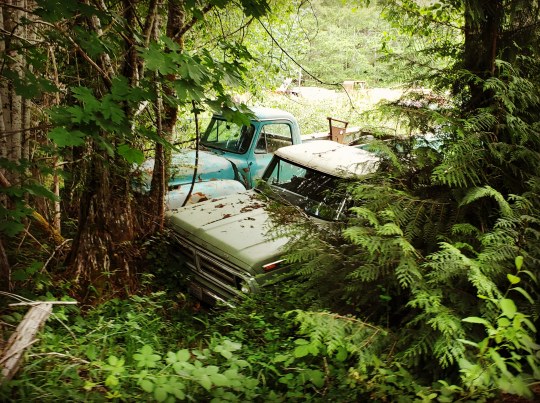
The line only has one grade crossing (meaning, an intersection where an active road crosses the tracks) requiring the guides to flag riders across at West Dayton Airport Road, after which much of the return ride is uphill. Vance Creek Railriders keep an unofficial record of the time to return to the start from this crossing, which we were told was set at 12′ 30″ the week before. Thanks to the powerful cyclist and two soldiers I was pedalling with, we set at new section record of 10′ 37″.

Vance Creek Railriders run on the final remaining section of track of the Simpson Logging Railroad Company. Founded in 1897 to bring timber from the dense Olympic Peninsula to the navigable southwestern extent of the Puget Sound, the logging railroad extended up to several hundred miles and included two of the highest rail bridges in the world. Per the Vance Creek Railriders website, the ”rail lines were in continual use for 120 years and became the last privately owned logging railroad in operation in the continental United States.”
By the time the railroad closed in 2017, it had been reduced to just 10 miles (16 kms) of track and served one lumber yard. Several idle locomotives can be seen by the remains of the lumber yard. Per site manager Cynthia Newman, the locomotives “belong to a non-profit called Simpson Railroad (Peninsular Railroad). They are in the process of raising funds to run an excursion train on the same portion of track. At the point they are ready to operate we will need to coordinate our schedules.”
I look forward to returning in the future to see how the operations run together.
The Vehicles
The vehicles are the same aluminum-framed, polyurethane-wheeled Railriders concept I described in the Railriders Cycling: Oregon Coast post, complete with upgrades such as retractable seatbelts, boat seats, Shimano chain tensioners, and front wheels made of a harder polyurethane compound for stability, as indicated by the color.
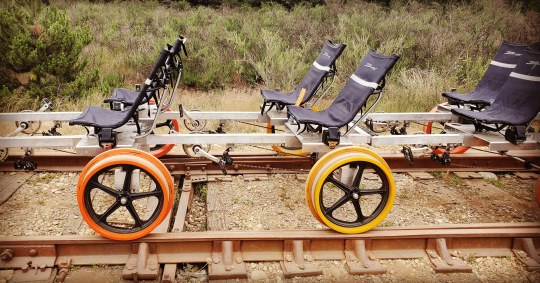
Of the 10 routes reviewed to date in this blog, Vance Creek Railriders are the only to run a fully motorized guide bike (as opposed to pedal assist electric motors).

The guide bike was in front on the outward descent and then in the back for uphill return. As the guide/driver explained to us, if anyone gets tired, they should just slow down and relax as he slowly packs the entire fleet together, bike-after-bike, to give it a push for the ride back.
Travel Notes

I pedalled this route as part of a railbike-rail-bike tour of the Northwest, arriving in Olympia by Amtrak the night before. To be sure, Vance Creek Railriders is most easily, safely and conveniently reached by car, but I decided try another way. I was travelling with a folding bike that I rode the 9.4 miles (15.1 kms) from the Amtrak station to downtown Olympia on the paved, enviable Chehalis Western and Woodland trails. By fortune, a classmate from grad school and top-notch cyclist lives in Olympia, so we rode his road bikes the 61.4-mile (91.8-km) round-trip from Olympia to Vance Creek and back. I do not recommend this to inexperienced cyclists given that much of the ride on the shoulder of a divided, four-lane highway, but we really enjoyed ourselves.
Given the long rides that day, and that I still needed to ride the 9.4 miles (15.1 kms) back to the station to catch a train to Seattle that evening, I had no time to explore the area. However, a quick search of the Shelton shows numerous outdoor activities where the Hammersley Inlet opens to the Oakland Bay on the city waterfront, over an abundance of fresh oysters and clams. Next time I’ll stay in Shelton.
2 notes
·
View notes
Text
Route Review: Railriders Cycling: Oregon Coast
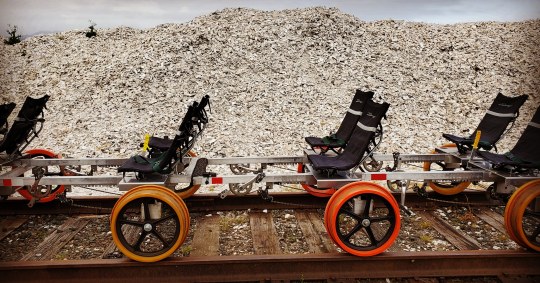
Railriders Cycling: Oregon Coast runs three routes along the renowned beauty of the Tillamook County shoreline, running on tracks of the Port of Tillamook Bay Railroad and sharing space with the Oregon Coast Scenic Railroad. The three routes currently on offer form one of three operations in the Northwest established by Kim and Anita Metlen, the pioneers of organized railbiking in Oregon and Washington. I rode the two routes described below on June 20th and 21st, 2019, although I unfortunately didn’t have time to schedule the Wheeler South route into my travel plans.
Vitals
Phone: 541-786-6165
Email: [email protected]
Website: https://ocrailriders.com/
Check-in Locations
Bay City to Tillamook: 5400 Hayes Oyster Drive, Bay City, OR
Wheeler North and South: 130 Marine Drive, Wheeler, OR
The Routes
The Wheeler North and South routes both start at a turnoff of in the north end of Wheeler, just as Highway 101 enters town. The 9-mile (14.5 km) round-trip Wheeler North route runs out of town along a vineyard and past dairy pastures before running on a trestle over the Nehalem River and then through ferny Northwestern forest.
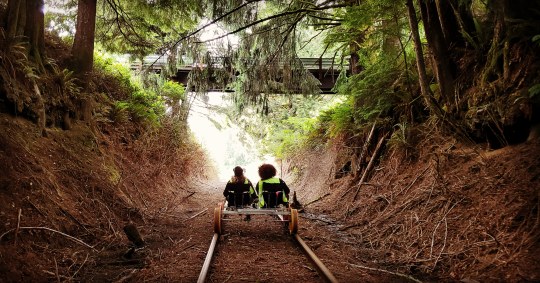
As noted in the introduction, I was unfortunately unable (or too absent-minded?) to fit the 10-mile (16 km) round-trip Wheeler South route into my travel plans. However, as I describe in greater detail in the Travel Notes below, my bicycle ride down the coast took me along the tracks where it was easy to appreciate the views offered along the Nehalem Bay. I’ll have to return to the area to ride this route.

The Bay City route also starts starts along Highway 101, 17 miles (27 km) to the south of Wheeler and just north of Tillamook. The 12-mile (19 km) round-trip ride commences by what I took to be the world’s largest mound of oyster shells (see the intro photo above), but when describing it to my Connecticut coast born and bred mother, she made it sound as if 3-story heaps of blue point shells were round every corner in Bridgeport and Norwalk. The route offers a mix of Tillamook Bay views and open farmland, crossing many bridges and trestles over wildlife filled bogs, all under the hills of the Northern Oregon Coast Range.
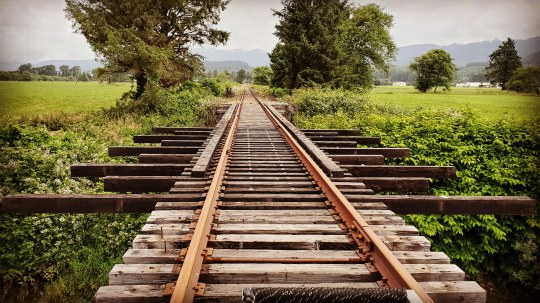
As noted above, the three routes described here are part of a larger family of railbike tours founded by Kim and Anita Metlen, who deserve great admiration for the work they’ve done to promote cycling and recreation in the Northwest.
The routes stand out from others I’ve pedalled in that the line is still formally active and under the jurisdiction of the Federal Railroad Administration. While the line doesn’t currently handle freight in the vicinity of the railbike operations, the railbikes do share track with the Oregon Coast Scenic Railroad, subjecting the railbikes to federal safety regulations that treat them as inspection vehicles. The result is that riders wear safety vests and Railrider Cycling staff members are trained to operate safely in the manner of railroad maintenance workers. Given that I was riding my bicycle between the routes in northwestern drizzle, I was already wearing a high-vis raincoat and qualified to ride directly without an additional vest.
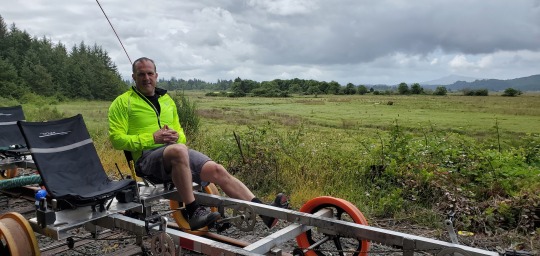
The line was originally constructed between 1906 and 1911 by the Pacific Railway and Navigation Company (PRN) to carry timber and agricultural products over the Northern Oregon Coast Range to Portland. Given the arduousness of maintaining a railroad in sopping coastal terrain, the line was dubbed Punk Rotten Nasty (PRN) by its workers. It was taken over by the Southern Pacific Railroad in 1916, and then the Port of Tillamook Bay Railroad as a shortline in 1990. Major storms in 1990, 1996 and 2007 segmented the line and mostly cut it off from the national network, although it has not been formerly decommissioned from future revenue service and a portion of the port operations, far from the segment used by the railbikes, still serves at least one lumber yard.
The Oregon Coast Scenic Railroad has been running excursion trains on the line since 2003. Raiilriders Cycling: Oregon Coast began the Bay City railbike route in 2016, and then expanded to the Wheeler North route in 2018 and the Wheeler South route in 2019.
The Vehicles
While all of the Railriders Cycling sites use a variant of the Railriders aluminum-framed and polyurethane-wheeled concept, the four-seat vehicles at Raiilriders Cycling: Oregon Coast regularly undergo creative re-engineering to ensure maximum performance and reliability. I rode the Wheeler North route with site manager Nate Bell (with Tara, half of the lovely couple running the three routes), who described his work in the engineering and economics of preventing wheel and hub wear, shaft flexion, and other concepts familiar to my work in railroad operations. Nate has been involved in the construction of all Railcyclers railbikes and told me that the “railbikes are ever-evolving, it’s the fun part about making them!”.
To my view, the quality of vehicle hardware was found in the seats, seat belts, and use of proven components such as Shimano chain tensioners.

Travel Notes
I pedalled the sites described above as part of a rail and cycling journey through the Northwest, reaching the coast after several days of enjoying the bikey-beery offerings of Portland. The obvious way to reach the coastal railbiking sites is by car, but I did find another option readers might enjoy. I picked up a folding bicycle in Portland, which I took on the Northwest Point bus to Cannon Beach, and then rode the 18 miles (30 km) to Wheeler to pedal the railbikes. Conveniently, both the seat and bike reservation can purchased through the Amtrak app on a smart phone. The Salmonberry Saloon in Wheeler offers fresh, local seafood and views of the Nehalem River.

After railbiking in Wheeler, I continued cycling south on the coast for another 17 (27 km) miles to Bay City to spend the night before railbiking there. I stayed in a cabin at the the Sheltered Nook, which I found on AirBnB and highly recommend. After leaving Bay City the next day, it was a short 5.5 mile (8.8 km) ride to Tillamook where I caught the NW Connector bus (bike rack on the front and space aboard) back to Portland.
Here is the beauty of riding a folding bike along the Oregon Coast:
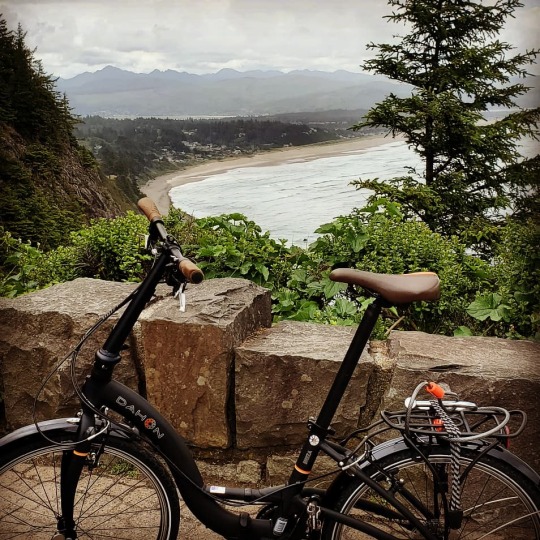
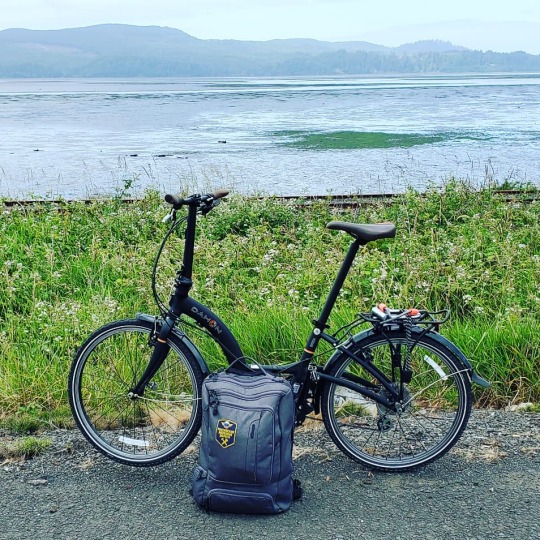
I hope that it’s apparent to any reader of this blog that, in addition to the post-apocalyptic attraction of pedalling carts along former economically critical infrastructure, I find pleasure and diversion in mobility. To that end, I offer this photo of progressive Portland, where urban mobility hits its resonant frequency in the point convergence of an aerial tramway, streetcar, bikeshare dock, and parking for about 400 bicycles. (and I took the photo from a pedestrian bridge alongside an outdoor, urban elevator where a scootershare was carelessly left in the way)...(and the blue thing in the upper left is a crane for loading and unloading barges on the Willamette River)...

#railbike#railbikes#railbiking#ocrailriders#tillamook#tillamookcounty#portoftillamookbayrailroad#oregon#oregoncoast#oregoncoastscenicrailroad#wheeleroregon#baycityoregon#highway101#nehalemriver#nehalembay#tillamookoregon#tillamookbay#oysters#northernoregoncoastrange#portlandoregon
3 notes
·
View notes
Text
Route Review: Railriders Cycling: Joseph Branch, Oregon
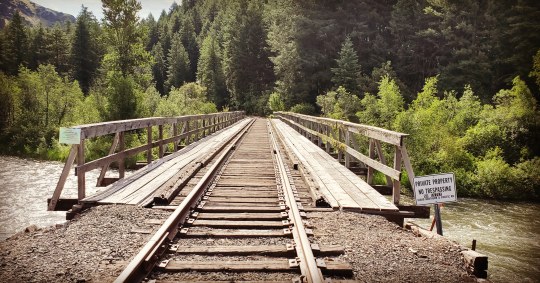
Running on the tracks of the Joseph Branch of the Wallowa Union Railroad, Railrider Cycling: Joseph Branch has offered railbike excursions in and around Joseph, Oregon since 2015. The three routes currently on offer collectively form one of three operations in the Northwest established by Kim and Anita Metlen, the pioneers of organized railbiking in Oregon and Washington. I rode the two routes described below on the weekend of June 16th and 17th, 2019, they have already added another.
Vitals
Phone: (541) 786-6149 or (541) 605-8295
Email: [email protected]
Website: https://jbrailriders.com/
Check-in Locations
Jospeh to Enterprise: 501 W Alder Street, Joseph, OR
Minam to Wallawa and Minam to Rondowa: 72601 Highway 82, Minam, OR
The Site
Railrider Cycling: Joseph Branch offers three separate and distinct rides, each on a regular schedule.
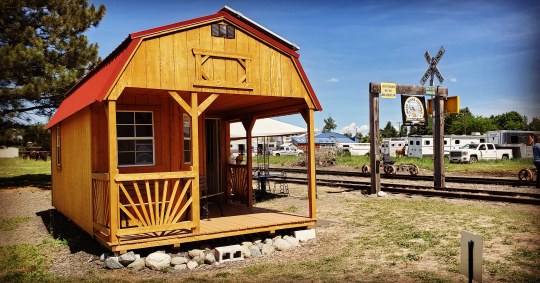
Check-in for the Joseph to Enterprise ride is at a baby-barn office on the edge of Joseph (see Travel Notes below for more details), where I was greeted by the Site Manager Robert Nichols and a Guide named Marshall, a true local whose family also offers horseback excursions in the surrounding mountains.
The Minam to Wallowa ride starts from a turnoff along Oregon Route 82, beside the Minam Store outfitter. I was the only rider on the day I pedalled this route, and my guide Zane was a young, fit football player just out of high school. We surely broke the course record that day.
Since my time there, they’ve added a third route from Minam to Rondowa, running in the opposite direction as the Minam to Wallowa ride.
As noted above, the three routes described here are part of a larger family of railbike tours founded by Kim and Anita Metlen, who deserve great admiration for the work they’ve done to promote cycling and recreation in the Northwest.
The Site Manager Robert Nichols notes that, “our branch options are so much fun because they are such a simple and enjoyable way to get away from it all. A few minutes of pedaling and you can escape the day to day craziness and enter into peaceful wilderness.”
The Routes
The Joseph to Enterprise 12-mile (19.3 km) round-trip runs through open farmland surrounded by the snow-capped Wallowa Mountians. The Minam to Wallowa 26-mile (42 km) round-trip runs through the Wallowa River canyon and includes a lunch break in Wallowa. On each route, riders can expect to see local fauna; I saw osprey, killdeer, deer, and snakes.

(Joseph to Enterprise)
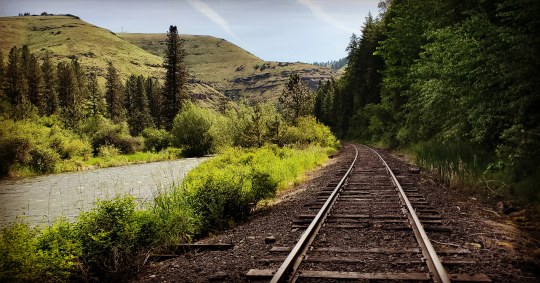
(Minam to Wallawa)
The line was initiated in 1890 by the Oregon Railway Extensions Company as a branch from the Union Pacific mainline from La Grande to Elgin, then extended to Joseph in 1905-1908 by the Oregon Railway & Navigation Company, totaling 63 miles (101 km). The line was intended to move timber from the dense forests of the region, but passenger service was offered as well. Ownership of the line was eventually transferred by consolidation to the Union Pacific Railroad in steps in 1910 and 1936, which operated mixed freight and passenger service until the 1960s (see the image just below) and freight from local timber operations until it was sold as a shortline to Rio Grande Pacific in 1993. In 2003, Elgin to Joseph tracks came under the ownership of the newly formed Wallowa Union Railroad Authority, which currently oversees freight and Eagle Cap excursion trains and, of course, railbikes.

(1960 Timetable, found at trainweb.org)
The Vehicles
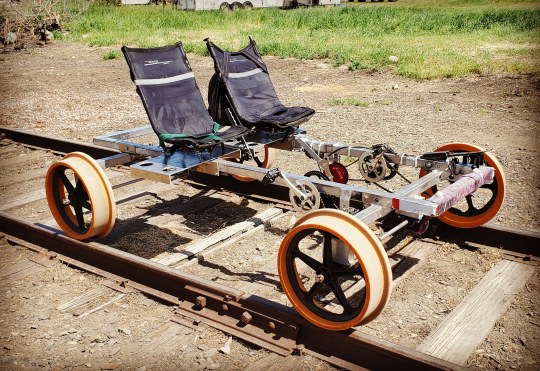
While all of the Railriders Cycling sites use a variant of the Railriders aluminum-framed and polyurethane-wheeled concept, Joseph Branch stands out in that they only run two-seater tandem vehicles. Site Manager Robert Nichols described some of the modifications they made to the original design, which are generally found in the nuts-and-bolts details providing increased reliability with decreased maintenance. Robert also notes that, “our retractable seatbelts are really handy, and...our brakes and the placement of where we have the handle works well and is convenient for our guests.”
See the image below of the Joseph to Enterprise guide vehicle, which has been outfitted with electric assist (compare to the vehicles at the Skunk Train). Also of interest is that Railriders Cycling sourced their own wheels. When writing about railbiking in Buffalo Creek, West Virginia, I noted that they had replaced the front wheels with cast-iron Speeder wheels to prevent them from climbing up the tracks and derailing in tight curves. This was accomplished on the Minam to Wallowa route by molding a harder compound of polyurethane (below in orange).


Travel Notes
I visited Joseph as part of a trip through the Northwest, from the Amtrak stop in Pasco, Washington and the neighboring Tri-Cities and inland port on the Columbia River. While Greyhound offers service to Joseph, neither transit nor cycling fit into my tight weekend schedule, so I opted to travel the 292-mile (470 km) round trip by rental car. The scenery along the ride was impressive, through farmlands, forest, high-desert scrub, around the the majestic Nine Canyon Wind Farm, and ultimately along the tracks of the Joseph Branch.
Joseph, formally a city of population 1,081 (what we’d call a hamlet in NY), is at the core of a region rich in outdoor activity, including hiking and horseback riding in the Wallowa Mountains, boating in Wallowa Lake, and fishing and kayaking on local rivers. I also saw rodeo grounds by the start of the railbike tour. The city caters well to visitors and includes art galleries, cafes and beerhalls and was recognized by the New York Times as the Oregon town to “try next.” From experience, I can recommend the Stein Distillery and the Jennings Hotel, which I booked on AirBnB.
6 miles (10 km) south of Joseph is is the must-see, must-do, must-ride Walowa Lake Tramway aerial cable car 3700 ft (1128 meter) ascent to the top of Mount Howard. Beyond the outdoor restaurant atop one can find paths leading to views of the lake and surrounding mountains, plus joyful creatures looking for treats.
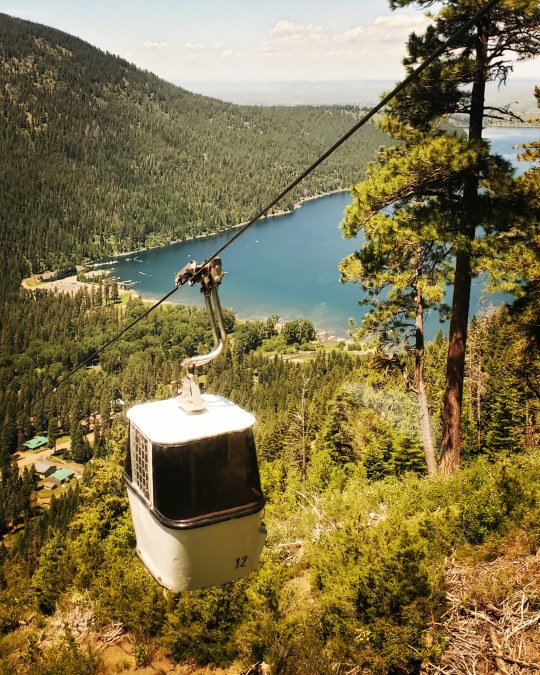

Back in the Tri-Cities, I enjoyed cycling on the paved trails along the Columbia River around Clover Island in Kennewick, Washington. I left the area on the Amtrak Empire Builder to Portland, overlooking the impressive staircase of hydroelectric dams on the Columbia River.
#railbike#railbikes#railbiking#josephbranch#josephbranchrailriders#railriders#railriderscycling#oregon#josephoregon#wallowaunionrailroad#enterpriseoregon#minamoregon#wallowa#wallowaoregon#lakewallowa#rondowa#rondowaoregon#minamstore#wallowamountains#wallowariver#oregonrailwayextensionscompany#unionpacific#lagrandeoregon#elginoregon#oregonrailwayandnavigationcompany#wallowaunionrailwayauthority#eaglecap#amtrack#pasco#washington
3 notes
·
View notes
Text
Route Review: NPOV Lion’s Club Rail Riders - Washington

The North Pend Oreille (”pon-der-ay”) Valley (NPOV) Lion’s Club Rail Riders commenced their second season of railbiking on the tracks of the Pend Oreille Valley Railroad on the weekend of June 15th and 16th, 2019. Running six full weekends through the season, this all-volunteer run service organization dedicates itself to betterment of the community of Ione and the “Forgotten Corner” of northeast Washington.. I pedalled the route though the valley from Ione on June 15th, 2019.
Vitals
Phone: 844 RAIL RIDE (844-724-5743)
Email: [email protected]
Website: https://lionsrailriders.com/
Check-in Address: 101 Railroad Ave, Ione, WA 99139
The Site
Check-in is at the station in the small village Ione, which formerly served the NPOV Lion’s Club excursion train (and across a parking lot from a bar and grille).

While the history of the line is summarized below, I’ll also share this direct quote from the NPOV Lions Club, describing the contributions they’ve made to the region over the years.
In 1981, NPOV Lions Club started a train ride...with a single flat car, wooden benches with chicken wire fencing...that carried 60 passengers along the scenic Pend Oreille River from Ione to Metaline Falls. The success of the ride over the years had increased to 7 train cars (including a caboose!) and ridership to over 10,000 guests each season. From humble beginnings, North Pend Oreille Valley Lions Excursion Train Ride rolled to a stop after 35 years of providing family fun on October 23, 2016.
This created a new challenge for NPOV Lions Club. Funds raised from the train ride supported local, regional, and international projects. Nothing could replace the train but NPOV Lions now have a new, exciting, family fun event…RAIL RIDERS!
The Route
The initial route is a 6-mile (9.7 km) round trip from the Ione station along the river to the turnaround at the trestle overlooking the magnificent Box Canyon Hydroelectric Dam. Upon return to the station, riders are offered an additional 3-mile (4.8 km) round trip through farmlands and forest south of Ione.


The line was originally constructed from 1909 to 1911 as the Idaho and Washington Northern (I&WN) to carry lumber and cement from the valley to larger, mainline markets. I cannot readily find evidence of passenger service, although it is easy to imagine that locals used the freight services as connections to mainline passenger services. Through various financial transactions, operation of the line was taken over by the Chicago, Milwaukee and St. Paul Railroad before being sold to the Milwaukee Road, who ran the line from 1916 until bankruptcy in 1979. This was followed by the public creation of the Port of Pend Oreille, which took over maintenance and operation of the newly named Pend Oreille Valley Railroad (POVA).
While the new venture initially served cement, newsprint and lumber operations, the NPOV Lions Club began running excursion trains in 1981. These trains ran a slowly expanding fleet until the cost of regular line inspections led to the 2016 discontinuance of rail service in the northern part of the line, opening the opportunity for railbiking, which commenced in 2018. Freight operations and the Newport Priest River Rotary Club SPORT (Scenic Pend Oreille River Train) continue further south on the line.
The Vehicles

As seen in many railbiking operations around the country, the NPOV Lions built their own bike based on the Railriders aluminum-framed and polyurethane-wheeled design. Lion Larry Pollack showed me the design and construction modifications he and the rest of the Lions made, including converting bolted connections to welds and moving the front wheels and axles to to the extreme front of the vehicles.
Moving the wheels to the front logically offers increased vehicle stability, but also created the challenge of decreasing seat adjustment range, potentially affecting taller riders. Larry explained that he has plans to deal with this and I look forward to seeing his next design update.


Travel Notes
I travelled to Ione as part of a trip through the Pacific Northwest while staying in Spokane, Washington. I didn’t see any good options for using public transit to reach Ione from Spokane for a day trip. Also, given that Ione is 85 miles (137 kms) north of Spokane, it would have been impractical to cycle there and back in the time I had, so I opted for a rental car. The drive was impressively scenic, running through hills and farmlands and ultimately paralleling the Pend Oreile River and Railroad. Nearby attractions include the Seattle City Light Boundary Dam and the Tiger Historical Museum.
The cultural and entertainment offering in Spokane (note to fellow North-Easterners: it’s apparently pronounced Spo-can) far exceed expectation with classic spots such as the Davenport Hotel and contemporary offerings such as the Volstead Act. The Spokane River waterfront is a charming park comprised of bicycle and pedestrian trails and bridges, featuring the Numerica SkyRide aerial tramway over the Spokane Falls hydro-electric generator.

Railfans, and fans of Americana in general, will appreciate Frank’s Diner, housed in a former Barney Smith railcar that once served as the presidential car for the Northern Pacific Railroad.

Amtrak’s once-per-day westward Empire Builder is scheduled to leave Spokane at 02:45. The train was delayed just enough for me to enjoy the sunrise as I boarded.

#railbike#railbikes#railbiking#npovrailriders#npovlionsclub#pendoreille#ionewashington#pedoreillevalleyrailroad#portofpendoreille#boxcanyon#boxcanyondam#railriders#spokane#spokanefalls#spokanewashington#seattlecitylightboundarydam#tigerhistoricalmuseum#davenporthotel#volsteadact#numericaskyride#franksdiner#amtrak#empirebuilder
3 notes
·
View notes
Text
Route Review: Rail Explorers Rhode Island Division
Sharing track with the Newport and Narragansett Bay Railroad, Rail Explorers Rhode Island Division runs two separate routes from their Portsmouth Grove station near the historic, seaside city of Newport, Rhode Island. Both rides run along bays on northern Aquindeck Island and offer their own, unique experiences. I pedalled both of these routes in July of 2017, so some of the details might have changed since then. The 2019 season launched on May 11 and is running five to seven days per week.
The Routes
The Northern Ramble is a 6-mile (9.7 km) one-way ride through varying scenery and terrain, from trestles over New England bogs to coastal forest canopy along the Narragansett and Mount Hope bays. At one point, it feels as if the rails are being engulfed by a golf course, at the next riders pedal under the majesty of the Mount Hope Bridge. I pedalled this route in both directions to enjoy the scenery from each perspective and highly recommend this to anyone up for 12 miles (19.3 kms) of railbiking.



The Southern Circuit is a six-mile (9.7 km) round-trip along the Weaver Cove and East Passage of the Narraganset Bay. The picnic area at the Bayside Station turning point is ideal for special event tours, such as the Fireside Friday, Sunday Brunch with mimosas, and enjoying the sunset over the bay.


Rail Explorers Rhode Island Division runs on track used by the Newport & Narragansett Bay Railroad Co., which has been running excursion and dinner trains since 2014. Former heritage railroads along the route included the Newport Dinner Train founded in 1997 and the Old Colony and Newport Scenic Railway founded in 1979. The line originally ran from Fall River, Massachusetts, ending scheduled passenger service as early as 1938 and freight service before 1973. A barge collided with the Sakonnet River rail bridge in 1988, resulting in the removal of the bridge in 2006, which then isolated the remaining section on Aquindeck Island from the national network.
Coincidentally, our AirBnB host told us that he was a member of a coalition dedicated to the conversion of the line to a rails-to-trails mixed-use path. I haven’t been able to find much evidence of such a coalition online, although there is a proposed plan from 2016 supporting this idea. However, per Rail Explorers founders Mary Joy Lu and Alex Catchpoole, the Rhode DOT has dominion over the use of the line and have given multi-year track use commitments to Rail Explorers and the Newport and Narragansett Bay Railroad.
This blogger fully supports rails-to-trail projects on disused railroads.
The Vehicles
The railbikes are the same steel frame and wheel models described in posts about the Rail Explorers Catskill Mountain and Las Vegas divisions shown here in Las Vegas in the Rail Explorers Instagram feed.
View this post on Instagram
A post shared by Rail Explorers USA (@railexplorersusa) on Dec 16, 2018 at 2:28pm PST
Travel Notes
When the ferries are running in the summer, there are many alternative routes for reaching Newport. On the outward journey, we took Amtrak from Penn Station to Providence where we transferred to the ferry to Newport. We returned by taking the morning ferry to Block Island, after touring the island taking the ferry to New London, CT, and then returning to NY by Amtrak.
Other potential routes include a combination of Long Island Rail Road to Greenport and ferry to Block Island or New London, Long Island Rail Road to Montauk and ferry to Block Island or New London, or the ferry from Jamestown.
Any of these journeys includes lighthouses, oysters, and arrival at the ferry terminal in Newport, where bicycle rentals can be found steps away at Hooley. The ride to Rail Explorer’s starting point is an easy 8.5 miles (13.7 kms) away.
Last note: Newport is a tourist town and full of top-notch dining options, so many restaurants fill up on summer weekends. Reservations are strongly recommended.

#railbike#railbikes#railbiking#railexplorers#newportandnarragansettbayrailroad#newportri#rhodeisland#narragansettbay#aquidneckisland#mounthopebridge
5 notes
·
View notes
Text
Route Review: Buffalo Creek Recreational Trail, WV
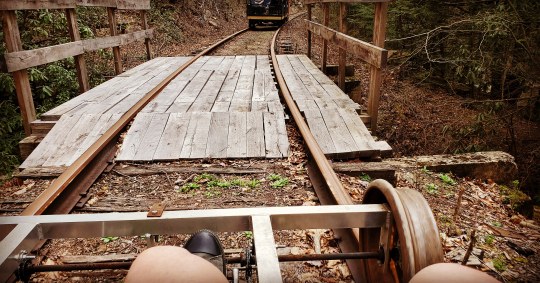
Running on the tracks of the former Buffalo Creek and Gauley Railroad, the Buffalo Creek Recreational Trail (BCRT) offers railbike and open-air railcar tours in a relaxed, interactive and highly hospitable environment. Under the umbrella of the Clay County Business Development Authority, the burgeoning trail is the grassroots beginning of an 18-mile (29-km) eco-tourism corridor for railbiking, cycling, horseback riding, kayaking, fishing, camping and Speeder-powered rail excursions. I pedalled the route on April 13th, 2019, the opening day of their second season of railbike tours.
The Site
Check-in is at 867 Buffalo Creek Road, just outside of the town of Clay and near the confluence of the Buffalo Creek and Elk River. BCRT has a gift shop at the check-in office, which, as the staff explained to me with great pride, was stocked only with locally made product, contributing thousands of dollars into the local economy to support crafts and handiwork. The start of the ride is collocated with an active little league baseball field and a campground and lodge, all coming together as an exhibit of the strong sense of local community.
While this is one of only a few routes to be reviewed in this blog that is in no way connected to a heritage rail operation, BCRT does offer powered options to enjoy the scenery of the Buffalo Creek. In addition to railbikes, they run a Speeder pulling bespoke open-air trailers, and optionally will tow the railbikes as well.

The Route
We rode 12 miles (19.3 kms) round trip on a section of the 18-mile (29-km) former Buffalo Creek and Gauley Railroad. The railroad was opened in 1904 and ran coal transport continuously until 1965, notably being the last US line to run steam engines in commercial operation. The route was reopened twice in the early 1970s and mid-1990s by other coal-related commercial interests, but saw its final revenue service in 1999.
While the section of track we rode is in relatively good shape, much of the line was destroyed by a flood in 2016. FEMA funds are in the works for restoration of the entire line, which would create opportunities to expand the railbike excursions well beyond the current route. BCRT staff shared ideas they had for the future of the line, such as setting up cabins along the way and renting railbikes to campers and fishermen for longer stays.
We were on the first run of the opening day of the season, so as it turned out, I was the only railbiker riding behind the speeder and trailers. We stopped several times to enjoy sights along the way, where BCRT staff shared history and local lore. While the entire route is through scenic forest canopy right along the Buffalo Creek, some of the noteworthy sites include former rail infrastructure, the remains of a derailed coal hopper, water-honed rock formations and a waterfall. The route passes through a clearing that was once a railroad company town called Adair, the only evidence left being a well-maintained cemetery. As described on a plaque in the clearing, the local school only gave instruction up to the eighth grade, so children rode the scheduled coal trains to get to Clay High School and back.
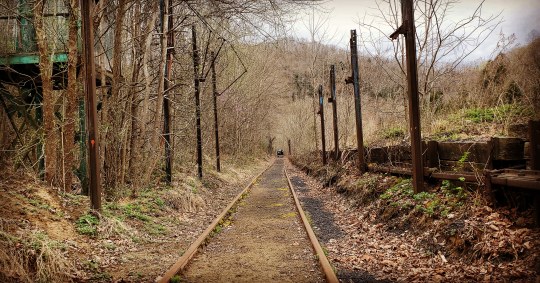
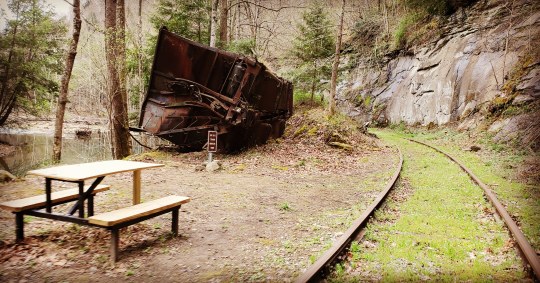
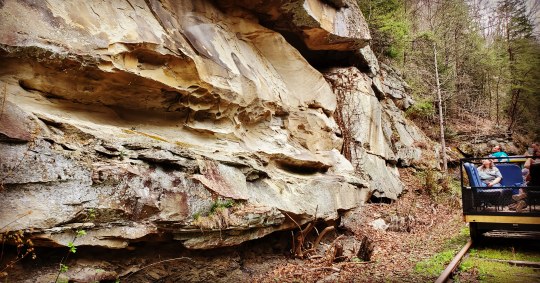
The Vehicles

In the DIY spirit of the the old coal rail line, BCRT keeps things simple. The railbikes are no-frills models from Railriders in Colorado. There are no seat belts and seat adjustments are held in place with eye bolts. This stripped down approach makes for a fast, fun ride, especially on the gradual slope of the return ride (where I had the fortune of riding 6 miles (9.7 kms) completely alone).
The only significant modification is the replacement of the stock urethane front wheels with cast iron wheels similar to those used on the Speeder and trailers. BCRT staff explained that the line has especially tight curves in which the urethane wheels would climb up the rails and derail, but the cast iron wheels slide through the curves. They also told me about some ideas they had for future modifications, such as adding motors and experimenting with driving the two front wheels independently (each wheel driven separately by each pedaller).
At the turnaround, BCRT staff had installed a jack-fitted lift for rotating the vehicles for the return trip. But it wasn’t necessary, the vehicles are light enough to pick up and turn.
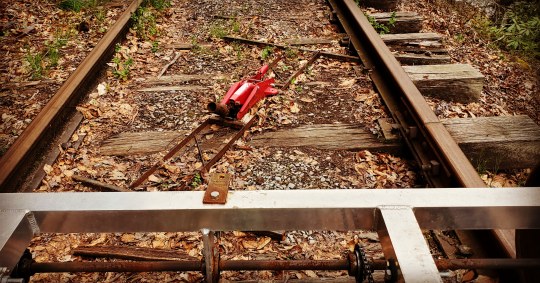
Travel Notes
Clay is 47 miles (75.6 kms) from the West Virginia capital Charleston. A sane person would arrive there by car. At the risk of simultaneously bragging and revealing my lack of sanity, I arrived by bicycle. I loaded my road bike onto the Amtrak in NY and rode to Charleston the day before, then rode my bike to Clay and back to Charleston. I’m not sure if the mixed modes count as a century ride, but I did pedal over 100 miles, adding the distances of the bicycle and railbike.
My only advice for cycling in rural West Virginia: carry pepper spray. There a many, many loving dogs waiting their entire lives on porches just for the chance to chase a cyclist.
#railbike#railbikes#railbiking#railriders#speeder#buffalo creek#buffalo creek recreational trail#buffalo creek rail rides#buffalo creek excursion#clay west virginia#clay county west virginia#clay county business development authority#buffalo creek and gauley railroad#charleston#charleston west virginia#west virginia
2 notes
·
View notes
Text
Route Review: Rail Explorers Catskill Division
Launched in 2018, the Rail Explorers Catskill Division River Run starts at the old train station in Phoenicia, NY and runs on track of the former Ulster and Delaware Railroad along the Esopus Creek. Since the Catskill Mountain Railroad ceased tourist operations on this scenic stretch of track in 2016, Rail Explorers has brought new life--and maintenance--to this historic line. I pedalled this route in July of 2018 and some details have changed as described below. Operations are closed for the winter, but will resume on May 18th and bookings are already being taken.
The Site
Nestled in the eastern Catskills, the start of the route is in the yard of the former Phoenicia Train Station, which is listed in the National Register of Historic Places and houses the Empire State Railway Museum. The yard and sheds are home to a collection of locomotives, coaches and cabooses. Until their lease with Ulster County expired in 2016, the Catskill Mountain Railroad used the station and equipment for tourist rides along the same alignment.
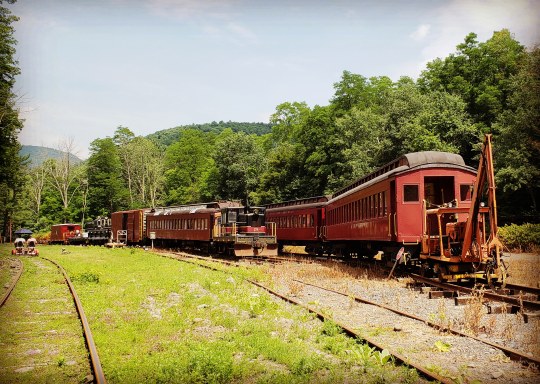
The Route
Running along the Esopus Creek, the River Run is a leisurely 8-mile (12.9 km) round trip beside campgrounds and country homes. At one point, the tracks cross Route 28 and the riders are treated to protection from traffic with crossing gates and signals originally installed for the railroad.
At the turnaround, riders wait in a seating area while the railbikes are turned around using on-track turntables (shown here in former routes in the Brandywine Valley, Delaware and Saranac Lake, NY).
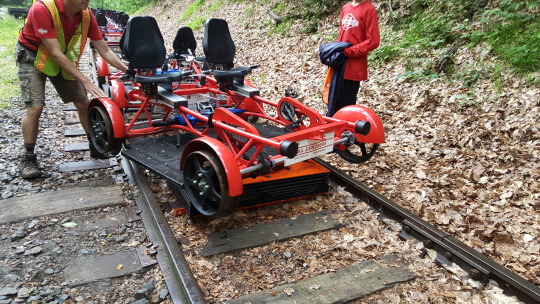
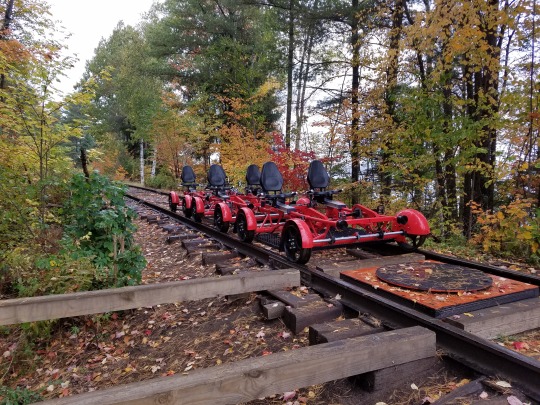
Given that the Esopus Creek feeds the Ashokan Reservoir, a major element of the NYC water supply, there are strict environmental standards in place along the route. Always innovators, Rail Explorers founders Mary Joy and Alex Catchpoole devised a way to keep the tracks clear of overgrowth without using polluting chemicals. Here is their trailer-mounted mower, which can be towed behind a rail bike.
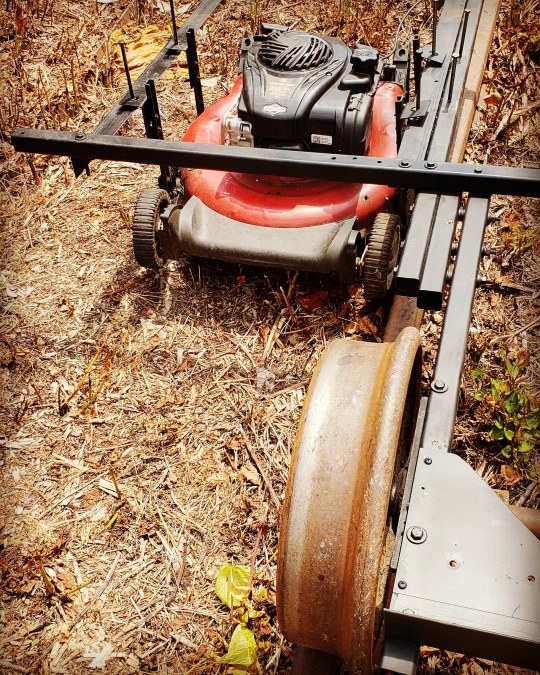
The 4 miles (6.4 km) used by Rail Explorers are part of 38 miles (61 km) of line owned by Ulster County, which is part of the greater line that formerly ran from Kingston Point on the Hudson River to Oneonta, NY where it met the Delaware and Hudson Railroad. Originally envisioned as a summertime-only connection to resorts in the Catskill Mountains, it eventually ran year-round carrying both passengers and freight and served branch lines to Hunter and Kaaterskill. The second half of the 20th Century saw the demise of the line, with mail and passenger service ending in 1954 and freight service ending in 1976.
The 2.4 miles (3.9 km) from Kingston Point to the Rondout neighborhood of Kingston, NY are now used by the Trolley Museum of New York. The section from Kingston to Hurley is used for tourist train excursions by the Catskill Mountain Railroad. Beyond Ulster County, the Delaware and Ulster Railroad run tourist trains around Arkville, NY.
Closer to Phoenicia, many bridges and creekside tracks have been washed away by storms and flooding since the closure of the railroad, isolating the section from other operations. Furthermore, exposed to similar spacial politics of several routes described in this blog, the future of the line is in question and subject to a legal battle over the use of the right-of-way, with Ulster County planning to remove much of the track to create a recreational trail. The section in use by Rail Explorers appears to be safe from this plan, although the future of the tourist trains remains unclear.
The Vehicles
I pedalled this route aboard the steel-framed, cast-iron-wheeled railbikes described in my earlier post on the Rail Explorers Las Vegas Division. However, as noted on the Rail Explorers website, they offer a “new Rail Explorers fleet of rail bikes, now with electric pedal assistance!” I look forward to returning to Phoenicia this year to see the new railbikes. Here is a great shot of a tandem from Saranac Lake on Rail Explorers Instagram account.
View this post on Instagram
A post shared by Rail Explorers USA (@railexplorersusa) on Feb 14, 2019 at 8:19am PST
Travel Notes
While Phoenicia is typically reached by car, Trailways offers daily buses from New York City through New Paltz, Kingston and on to Oneonta. It is a short walk from the center of the hamlet to the starting point at the station. The completion of the Empire State Trail in connection with the recreational trail planned by Ulster County might offer options for reaching Phoenicia by bicycle in the future.
Phoenicia is a popular tourist destination, perhaps best known for whitewater tubing along the Esopus Creek, and centrally located near many options for hiking, skiing and fly-fishing. Nearby Belleayre Ski Resort offers summertime gondola rides for hiking, mountain biking and sightseeing. Main Street in Phoenicia has a small stretch of shops, pizzerias, bars and restaurants. The nightlife in nearby Woodstock has picked back up in recent years, especially thanks to the Station Bar and Curio, where one can enjoy drinks and live music in a station that used to serve the same line described above.
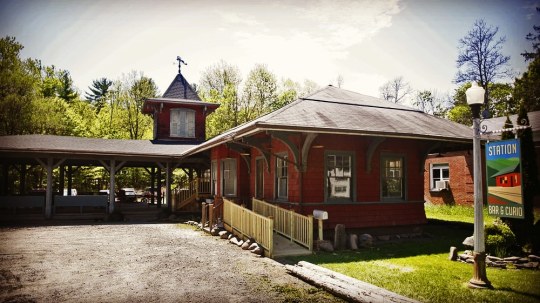
#railbike#railbikes#railbiking#railexplorers#phoenicia#phoeniciany#catskills#catskill mountains#empire state railway museum#catskill mountain railroad#delaware and hudson railroad#trolley museum of new york#esopus creek#belleayre#kingston new york#woodstock#pinehill#arkville#station bar and curio
4 notes
·
View notes
Text
Route Review: The Skunk Train

Running through the Pudding Creek estuary below the coastal town of Fort Bragg, California, the California Western Railroad has recently commenced their second season of railbike tours. The 7-mile (11.3 km) round-trip takes riders across several small bridges over the milky Pudding Creek and under patches of redwood trees, all surrounded by the nature of coastal California. I rode this route on March 9th, the second day of the 2019 season, which lasts until November.
The Site
Check-in was in downtown Fort Bragg at the “Skunk Train” station, named for the former gas-burning, self-propelled railcars that ran along the line, said to emit such an odor that the locals would quip, "You can smell 'em before you can see 'em." Upon arrival, the excursion train was was out on a run, but there was still one historic passenger coach in the yard to admire. The Mendocino Coast Model Railroad and Historical Society is next door.
The railbike route starts at a short walk across downtown, which has an active business district for lunch and shopping. Note that this is one of only a few examples of lines on which railbikes and tourist trains are run by the same outfit, so ticketing and other operations are completely integrated.

The Route
Leaving town, the line runs down a relatively steep grade to the Pudding Creek estuary. It was raining when we rode, so we didn’t see any of the native heron or osprey but, as noted above, the creekside and redwood forest scenery were outstanding.

The turnaround is in a clearing called Glen Blair Junction where there a is switch for a former branch to an erstwhile logging camp. There is no turntable or other mechanism for turning the bikes around, they are light enough for two people to lift and turn themselves.
As noted by the Chief Skunk Robert Jason Pinoli, “the thing that is so cool about the Railbikes as it meshes with the 134-year-old Skunk Train operation is that someone who has been a previous passenger of ours and has ridden the rails countless times and loves the Redwood Route™ will surely want to come back for this new experience.” He also notes that the railbikes speak to people of all ages and are a natural extension of of the open-air rail cars, in that they provide “that same awe-inspiring sense of being amongst the giant redwoods, coupled with your inner kid being unleashed on a bike.”

Past, Present & Future
The 3.5 miles (5.6 kms) of track used for the railbike route are part of the 40 miles (64 kms) of the California Western Railroad (CWR), which runs inland from the Pacific Coast at Fort Bragg to meet the Northwestern Pacific Railroad at Willits, California. The CWR started as the Fort Bragg Railroad in 1885 to move timber from nearby logging operations to the coast for shipment. Over the following 25 years, it was extended in sections to Willts and passenger service was introduced. While the route flourished in the first half of the 20th century, passenger services gradually declined to only tourist excursion trains while freight services ended completely by 2001.
In 2016, Tunnel #1, which connects the Pudding Creek and Noyo River valleys, was blocked from storm damage, isolating the 3.5 mile (5.6 km) Pudding Creek section from the rest of the line and the national network. The Skunk Train runs tourist trains on both sides of the blocked tunnel, and, according to Pinoli, “we are looking to build 12 more bikes and run them in the Noyo River canyon. Not to mention we are looking to build some to run out of Willits whereby you’d take the train to the ‘launch’ point, do the ride and then catch the returning or next train.”
The tunnel is currently under repair and will eventually reconnect the line to Willits, where there are proposals of connecting to expansions of either the Northwestern Pacific Railroad or the Sonoma-Marin Area Rail Transit (SMART). Moreover, when the tunnel is repaired, Pinoli also intends to run his railbikes through the 1,122-foot (342 m) tunnel.

The Vehicles
Skunk Train built their own frames from scratch, using urethane wheels from RailRiders in Colorado and electric assist drivetrains from the the Australian Engineering firm Dillenger. I tested the assist a bit on the return climb and could feel a significant boost up the hill. It was also fun being able to see our speed displayed along the way.
On another note, it rained fairly heavily on our return ride, which gave me the opportunity to test hard braking of urethane wheels on smooth, wet tracks. I was able to get the vehicle to slide, but only for a short distance before it came to a stop.



Travel Notes
Fort Bragg is 170 miles (275 kms) north of San Francisco and best reached by car (unless the Skunk Train is ever connected to the SMART). Fort Bragg and the surroundings in Mendocino County are rich with sights to round out the trip, including noteworthy points along the Pacific Coast Highway such as the Point Arena Light, the Point Cabrillo Light, and the 1812-built Russian Fort Ross. Further south on the bank of the Russian River is the cultural center Russian House #1, where you can get borscht and other delights from a home cooked buffet and pay “according to your heart.”
#railbike#railbikes#railbiking#skunktrain#californiawesternrailroad#mendocinorailway#fortbragg#mendocinocounty#puddingcreek#noyoriver#northwesternpacificrailroad#sonomamarinarearailtransit#pacificcoasthighway#pointarenalight#pointcabrillolight#fortross#russianriver#russianhouse1
3 notes
·
View notes
Text
Route Review: Revolution Rail Co. in North Creek, NY

Founded in 2017 by former Rail Explorers employee Rob Harte and partner Mike Dupee, Revolution Rail Co. runs along the Adirondack Railway north of the quaint, ski hamlet of North Creek, NY, at one point crossing the Hudson River where it is as small as a mountain creek. I pedalled this route in August of 2018. While operations are currently closed for the winter, they resume on May 11th.
The Site
Check-in is at the North Creek Station, which until recently was the northern terminus for the Saratoga and North Creek Railway and is listed on the National Register of Historic Places. While the tourist train from Saratoga Springs ceased operations last year and left the future of the entire line in question, the train and a few historic coaches and locomotives were still on site. The station, well-placed in an Adirondack hamlet, is a simple structure that feels like a cozy barn inside. A smaller, adjacent building houses the North Creek Depot Museum.

The Route
After a short drive north of the station in a former school bus, the railbikes were waiting on the tracks by a small turnoff. On the six-mile (9.7 km) round-trip ride, the tracks run along and over the Hudson River and then briefly along the Boreas River, all under the Adirondack forest canopy. The highlight of the trip is the trestle over the Hudson.

At the far point of the route, the riders leave the railbikes and walk down to the banks of the Boreas River while the bikes are turned around for the return trip. A small, bespoke turntable on the tracks is used, as seen in the photo and RevRail Instagram post below.

View this post on Instagram
A post shared by Revolution Rail (@revrailco) on Aug 18, 2017 at 6:44pm PDT
The Vehicles
According to our guide, the vehicles were entirely designed by the founders. The frames are made of tubular and plate aluminum bolted together. The drivetrain, wheels and some other components appear to be supplied by Railriders.
It’s worth noting here that the ride was delayed because of an intense thunder and lightening storm and the tracks were sopping wet when we rode them. The braking felt secure, although I had no need (opportunity?) to test hard-braking of polyurethane wheels on wet rail.

Travel Notes
Initially a logging camp, the hamlet of North Creek grew from the tanning and raw garnet mining in the area. By the 1930s, The North Creek Ski Bowl had been established and by the 1960s New York State opened the Gore Mountain ski resort, making both Alpine and Nordic skiing the main draws of the hamlet.
In 2014, I travelled to North Creek for a weekend of Nordic skiing. At that time, It was still possible to travel all the way by train by taking Amtrak to Saratoga Springs and transferring to the the (sadly now defunct) Saratoga and North Creek Railway, which, in my case, required a fun night out in hopping Saratoga Springs before boarding the morning train to North Creek. The trains offered elegant, white-linen table service in big, comfy seats and served local fare prepared onboard. Because the tourist train has stopped running indefinitely, I opted to visit Revolution Rail Co. by rental car from the Amtrak station in hard drinking Schenectady, NY.
For those who stay in North Creek, there is a small but high-quality selection of bars, restaurants and cafes on Main Street. The Gore Mountain gondola lift is a great attraction, both in that many of the former gondolas are on display in and around North Creek, and in that the lift itself is open year round for skiing, hiking, Autumn leaf-peeping and mountain biking.


#railbike#railbikes#railbiking#revrail#revolutionrail#northcreek#northcreekny#adirondacks#adirondak mountains#saratoga#schenectady#railriders#hudson river#saratoga and northcreek railway
5 notes
·
View notes
Text
Route Review: Rail Explorers Las Vegas Division
As we bundle up in the deep northern freeze, the only railbiking route below the 40th parallel is running strong in the temperate winter of southern Nevada. Rail Explorers are in their second season in the pleasant, heart-shaped town of Boulder City, Nevada, close to both Las Vegas and Lake Meade. I’ll review the route in this post, but please note that I pedalled the line last year, so some of the details might have changed since then.
The Site
The site and line are shared with the Nevada Southern Railway Museum and heritage rail, which feature strongly in the overall experience. The railbike ticket includes entry to the museum, which is at the start of the ride and displays heritage locomotives and and other well-preserved rail vehicles and artifacts.



The Route
The route itself is a leisurely 4-mile (6.4 km) downhill pedal through the desert outside of Boulder City. However, per Alex Catchpoole, half of the dynamic duo that founded Rail Explorers, the line is currently being expanded with a new bridge over US Highway 93, which would connect to neighboring Henderson, Nevada and create the infrastructure to add significant length to the route.
At the end of the line, there is a small seating area where riders relax while a heritage train follows from the same origin. The railbikes are then towed back to the museum and the railbikers are treated to a ride back aboard the train. The scenery and train are featured in this excellent clip from Rail Explorer’s Instagram feed.
View this post on Instagram
A post shared by Rail Explorers USA (@railexplorersusa) on Feb 4, 2019 at 2:05pm PST
The Vehicles
I plan to write a longer post on the various configurations and types of railbikes on offer on the routes I ride, so I’ll keep this brief. Rail Explorers are the only North American railbiking organization to use fully steel-framed and cast-steel-wheeled vehicles built in Korea and similar to those in use on the Jeongseon route. While the vehicles are heavier than the aluminum-framed and polyurethane-wheeled vehicles used on other North American routes, they are easy to move from a standstill and feel rock-stable on the tracks.

(A steel-wheeled Rail Explorers vehicle on the tracks in Boulder City)
Travel Notes
To get from my hotel in Las Vegas to Boulder City the morning of the ride, I rented a bike through spinlister (the AirBnB of bicycles) and rode about 30 miles (48 kms) each way along a series of idyllic, well-maintained, freshly-paved bike paths through the suburbs and open desert.

These trails are part of a larger network that connect Las Vegas with nearby towns and Lake Meade and are well worth the time spent riding them. In addition to spinlister, there are other bike rental shops around town. Las Vegas also has a bikeshare system, which works well for trips in the city but perhaps not for the long ride to Boulder City, which would incur massive overage fees (but actually might be cheaper than the cost of a daily rental from a bike shop).
Finally, note that Las Vegas is unique in the world by having both an urban monorail and three cable-pulled automated people movers (APMs). After the long day riding back and forth to Boulder City, I treated myself to a monorail/APM pub crawl up and down the strip. Go ahead, enjoy!

1 note
·
View note
Text
Introduction to the Railbike Blog
Welcome and thank you for visiting the Railbike Blog, a place that I intend to develop as the premier resource for railbiking in North America. Over the coming months, not only will I write reviews of each of the excursions currently on offer, I’ll also explore the people, politics and technology that have shaped modern railbiking.
What is railbiking? While I offer a more specific definition below, it is exactly as it sounds: pedal-powered vehicles used on railroad tracks.

In the past two years, I’ve pedalled 8 routes and count another 8 across the continent to pedal this year. Please let me know if there are any excursions I’ve missed and should add. Also, if anyone knows of a legal opportunity to ride a bicycle fit with an outrigger for rail travel (photo above right), please let me know. Here is the list of North American routes to the best of my knowledge.
Previously Pedalled:
Rail Explorers Rhode Island Division: The Northern Ramble and the Southern Circuit
Rail Explorers Las Vegas Division: The Southwest Ramble
Rail Explorers Catskills Division (NY): The River Run
Rail Explorers Adirondack Division (NY): Saranac Lake to Lake Clear and “Into the Wild” from Tupper Lake to Lake Clear (neither currently on offer)
Rail Explorers Delaware Division: Brandywine Valley (not currently on offer)
Revolution Rail Co: North Creek, NY
Planned to Pedal:
Railriders (WA): North Pend Oreille Valley Lions Club
Railriders Joseph Branch (OR): Joseph to Enterprise and Minam to Wallowa
Oregon Coast Railriders (OR): Bay City to Tillamook and Wheeler
Vance Creek Railriders (WA): Camp 1 to Shelton
Adirondack Scenic Railbike Adventures (NY): Round trip Thendara to Carter Station
Belfast and Moosehead Lake RailCyclers (ME)
Please read below for my working definition of modern railbikes, along with a brief history of the concept. In coming posts, I’ll offer more detail on how the current vehicles and routes came to be. I look forward to sharing this with you.
Definition
For the purposes of this blog, a Railbike is a non-motorized, pedal-powered rail vehicle used for inspection and maintenance-of-way or for recreation on railroad lines. Railbikes are distinguished from motorized draisines in that they are pedal-powered in the manner of bicycles. For the same reason, they are further distinguished from handcars, velocipede handcars, and hand-powered draisines (NB, European systems tend not to use this distinction and use the generic term draisine universally). While initially used for track inspection and light transport of rail materials, typical modern examples are for recreational tourist excursions. Most modern railbikes run on disused railroads or on shared track with tourist railroads, although this does not preclude railbikes from operating on purpose-built tracks.
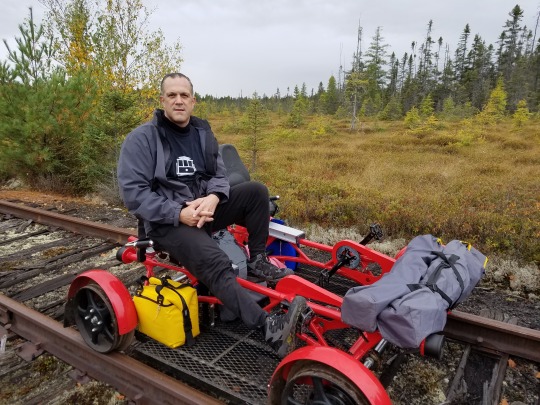
(The author on a Rail Explorers tandem railbike during the “Into the Wild” excursion in October of 2016, Tupper Lake - Lake Clear, Adirondacks, NY)
A Brief History
Unsurprisingly, the evolution of the railbike is tied closely to the evolution of both the railroad and the bicycle. Given the need for a lightweight rail inspection vehicle, light enough to be easily removed from tracks to clear the way for oncoming trains or to reverse direction of travel, the inventors Perry and Aspinwall patented the original three-wheeled velocipede hand-car, which was later improved and mass-produced by the George S. Sheffield Company of Three Rivers, Michigan, US in 1883 [1] [2].

(Advert for Geo S. Sheffield's early three-wheeled handcar, 1883 [4])
Following the introduction of the chain-driven bicycle in the late 1860s, which was mass-produced starting in 1885 by British inventor John Kemp Starley as the Rover Safety Bicycle, Charles N. Teetor of Hagerstown, Indiana, US, patented a four-wheeled pedal-powered railbike called the Railway Velocipede, one of the earliest examples of a pedal-powered railway vehicle [3]. A side-by-side tandem version with passenger seating was produced by Orenstein & Koppel of Berlin, Germany six years earlier [4].
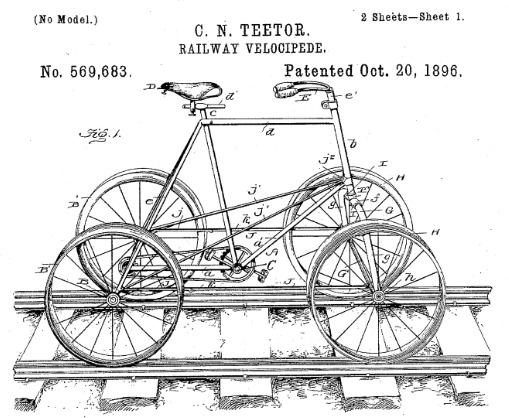
(Sketch of Teetor's pedal-powered, chain-driven Railway Velocipede from the original 1895 patent [3])

(Orenstein & Koppel side-by-side tandem with passenger seating, c.1890 [4])
Following Dunlop's 1887 invention of the pneumatic bicycle tyre and subsequent mounting improvements by Michelin in 1891, the Sears and Roebucks Catalog offered the "Harris 20th Century Railroad Attachment" in 1908. The catalog described the attachment as transforming "the ordinary bicycle into the most practical and durable device obtaining high speed on railroad tracks, making a regular railroad velocipede out of an ordinary bicycle...this attachment has become very popular with railroad and telegraph employees, both male and female" [1] [4]
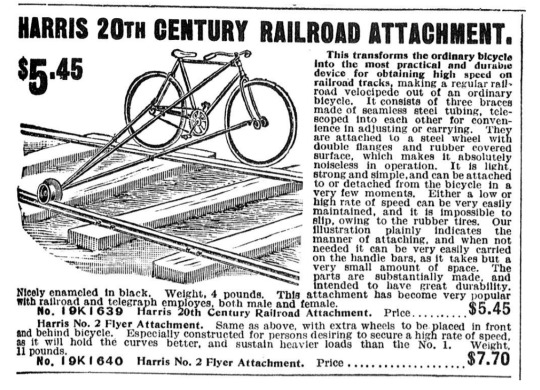
(Harris 20th Century Railroad Attachment as seen in the Sears and Roebuck catalog, 1905 [1])
Abandonment Creates Room for Recreational Railbikes
The 20th-century trend toward the use of private automobiles, buses and airplanes decreased the use of trains in many countries [5]. Large-scale abandonment of railroads followed the Beeching cuts in the UK in 1963 and the Railroad Revitalization and Regulatory Reform Act in the US 1976, the latter leaving almost 35,000 miles (56,000 km) of disused track [1]. By the mid-1970s, the magazine Popular Mechanics advertised conversion kits for using standard bicycles on abandoned railroads available from the American Railbike Association [6]. Thus, the abandoned railroads created a space for a new form of leisure.
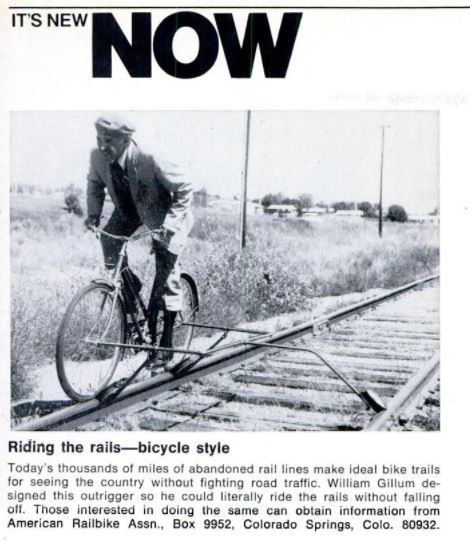
(Advert for conversion kit, Popular Mechanics, February, 1976)
References
Melin, B., Railbike: Cycling on Abandoned Railroads, Balboa Publishing, San Anselmo, CA, 1996
US Patent RE10303 E, Handcar, https://www.google.com/patents/USRE10303
US Patent 569683 A, Railway Velocipede, https://patents.google.com/patent/US569683A/
Thomas, J., Historic Builders of Velocipedes and Other Hand Powered Vehicles, http://velocipedes.blazerweb.co.uk/newsletters/Newsletter19b.pdf
Gallamore, Robert E. and Meyer, John R., American Railroads: Decline and Renaissance in the Twentieth Century, Harvard University Press, 2014
Popular Mechanics, It's New Now: Riding the Rails-Bicycle Style, February, 1976, p 87, https://books.google.com/books?id=B-IDAAAAMBAJ&printsec=frontcover&source=gbs_ge_summary_r&cad=0#v=onepage&q&f=false
#railbike#railbikes#railbikeblog#railexplorers#revolutionrail#railriders#adirondackscenicrailbikeadventures#railcyclers
5 notes
·
View notes